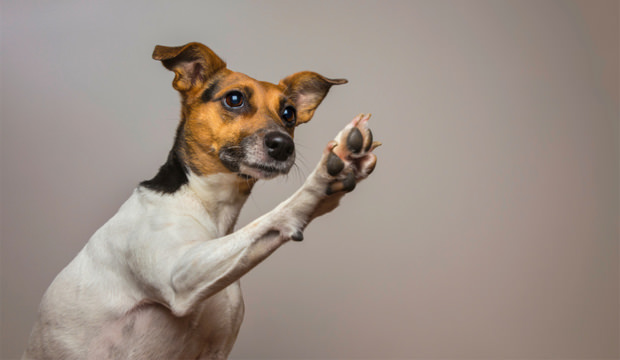
Dogs provide us with hours of entertainment, a shoulder to cry on and endless love and affection. No matter how bad your day was, coming home to a jumping, licking excited ball of fur will lift your mood and make you forget your troubles instantly.
All dogs love to please their owners, and teaching your dog tricks is a great way to let him win your praise and affection. To keep your dog safe and mentally stimulated, it is essential to teach him basic commands such as sit, stay and heel.
If you wish to take his training further, the following tricks will test his mental and physical abilities to the limit.
1. High five
Start by commanding your dog to sit, and reward him with a treat. Next, hold a treat in front of him but slightly out of reach.
Repeat the command “high five” whilst gently tapping one of his feet. Most dogs will raise their foot to paw at the treat in your other hand.
As he raises his foot, catch it with your free hand. As soon as you make contact, give your dog the treat and lots of praise.
Keep repeating these steps until your dog raises his foot automatically every time you give the command. If your dog needs a little encouragement to lift his foot off the ground, gently tap the inside of his knee with your finger until he bends his leg.
As soon as his paw is off the ground, gently tickle the bottom of his foot to encourage him to raise it higher. Continue to say the command slowly and firmly as you repeat the steps.
Keep your pooch healthy – Click Here to Buy the best supplements & vitamins
Some dogs will eventually be able to perform this trick without you having to give the command. Simply commanding your dog to sit and then raising your hand in front of him will be enough to get him to give you a high five.
2. Army crawl
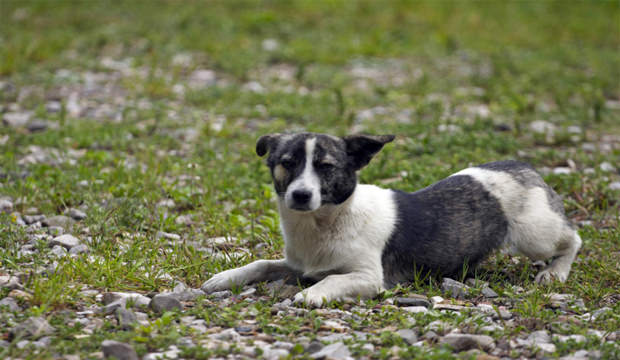
Some dogs will begin to crawl without training when attempting to sneak onto the couch or hoover up crumbs from the carpet.
Start by commanding your dog to lie down. Hold a treat firmly between your fingers so that your dog can smell and lick the treat but cannot take it from your hand.
Hold the treat in front of your dog’s nose, and slowly drag it along the floor. As soon as your dog crawls just a few feet, praise him, and give him the treat. If the dog stands up to take the treat, quickly take it away, and start again from the beginning.
Try to get your dog to crawl for a slightly longer distance each time. Once he has mastered the trick, command your dog to lie down when he is at least 10 – 15 feet away, and then get him to crawl towards you.
Click Here to Buy the Best Training Clickers for your dog
As well as being an entertaining trick, teaching your dog to crawl may even come in handy in real life situations. If you enjoy mountaineering or hiking with your dog, you may come across dangerous terrain or small caves that require him to crawl for his own safety. It is also a handy skill for hunting dogs.
3. Dance
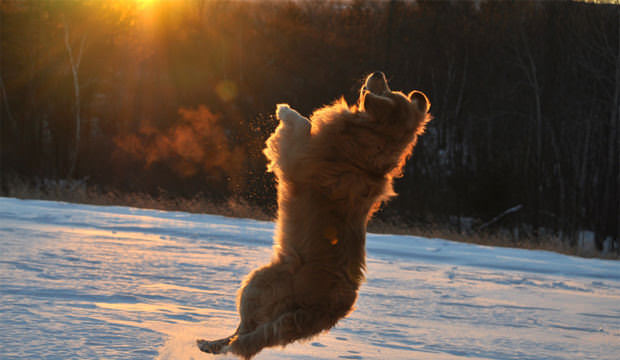
However, this trick is not recommended for dogs that are overweight or suffer from problems with their hind legs.
From the sitting position, raise a treat slowly up and over your dog’s head. Repeat a command such as “up”, “dance” or “spin” until he rises up on his hind legs.
You might need to move the treat slightly behind your dog’s head to get him to stand up. If your dog already has good balance, hold the treat in front of his nose, and then slowly move it around his head until he spins in a circle. Larger breeds such as Labradors and Bull Mastiffs may be slightly unsteady on their feet to begin with, so let them get accustomed to just standing up before getting them to spin.
Train your pupp with Dog Whistles – Click Here to Buy on Amazon
If your dog is especially large and excitable, take care when commanding him to stand up. Some dogs will use their front paws to push you if they get excited which could end in disaster if they weigh more than you do. Smaller breeds such as poodles, Yorkshire terriers and chows are best suited for this trick.
4. Collect garbage
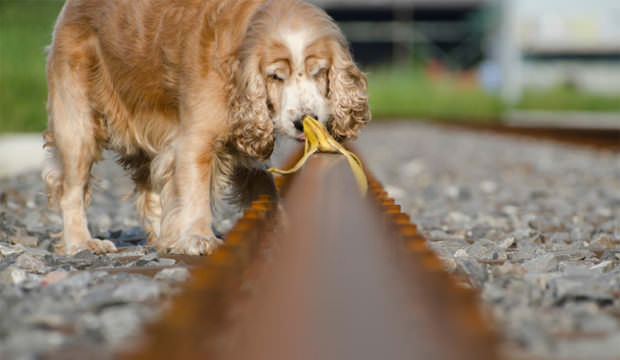
Teaching your dog to collect garbage is similar to teaching him how to play fetch.
Next time you take your dog for a walk, take some tissues or pieces of paper with you. Take him to a wide open space, and then throw one tissue into the air.
Command your dog to fetch the tissue and bring it back to you. If your dog does not yet know how to fetch, start by pointing to the item you want him to bring, and repeat the command. If he does not respond, walk over to the item with a treat in your hand so that your dog will follow you. Guide him towards the item or pick it up and offer it to him until he grasps it in his mouth.
The Best Flying Discs are available on Amazon – Order Here
After your dog masters holding the item in his mouth, start moving away from your dog slowly while commanding him to stay. After you have moved back at least 10 feet, call your dog towards you. Give him a treat only if he returns with the item in his mouth. Only command your dog to fetch your own garbage to avoid sharp items and harmful chemicals.
5. Salute
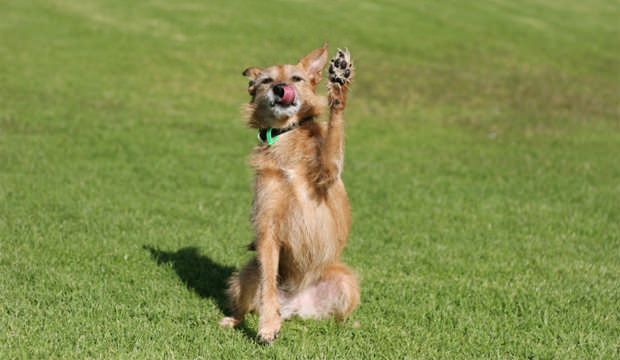
Command your dog to sit in front of you, and administer a treat. Take a yellow post-it note or small piece of tape, and stick it just above your dog’s eye.
As your dog raises his paw to remove it, give him plenty of praise, and reward your dog with a treat.
If your dog has extremely long fur or is afraid of the tape, there is another method to teach this trick. Ask your dog to give his paw, and then gently raise it over his head.
As soon as it reaches over his eye, say the command, and administer a treat. With a little patience, you will eventually get your dog to salute you just by hearing the command.
Take good care of your pupp – Find the Best Shampoos & Conditioners on Amazon
Be wary of what command you use to entice your dog to give a salute. A 71-year-old pensioner in Berlin was sentenced to five months in jail for teaching his dog named Adolf to give a Nazi salute after hearing the command “Heil Hitler.” The Alsatian-cross was taken into care in one of Berlin’s animal shelters where he was renamed Adi and put up for adoption.
6. Skateboard
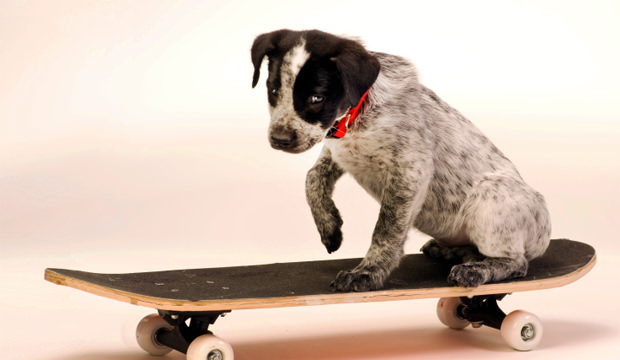
Smaller breeds such as bulldogs and pugs are perfect for this trick as they have a lower centre of gravity. Start by introducing your dog to the skateboard gradually.
Some dogs can be terrified of a noisy, moving object that has the ability to chase them, so it is important to break them in slowly.
Place the skateboard upside down on a carpeted surface to allow your dog to inspect it at his own pace. Praise and reward him for any interest he shows in the skateboard. Spend a few sessions simply doing this and gently spinning the wheels to let him get comfortable before proceeding to the next step.
Turn the skateboard the right way up, and start slowly rolling it away from your dog on the carpeted surface. Never roll it directly towards your dog as this may spook him. Take the skateboard outside, and continue rewarding your dog every time he shows interest or touches the skateboard.
Cookies, Biscuits & Snacks perfect for your pooch – Click Here to Buy
Slowly begin to entice your dog to mount the skateboard. You may have to give your dog some gentle encouragement at first by lifting him onto it. Once he stands still, reward him generously. Begin to build up your dog’s confidence before graduating to pushing him on the skateboard. Once he feels safe and secure, gently roll him forwards and backwards whilst praising and administering treats.
7. Kiss
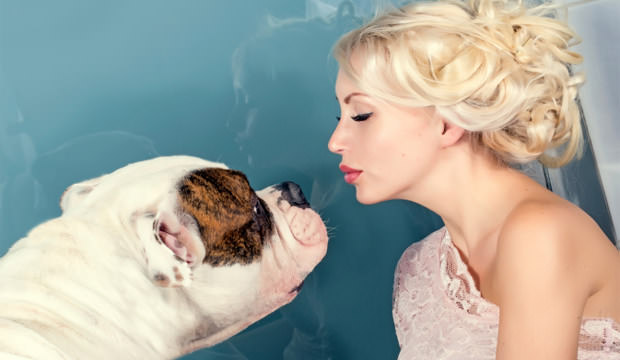
Hold a treat in front of your face, and say the command. Offer your cheek towards your dog, and wait until he touches it with his nose.
As soon as he makes contact, pull away, and give him the treat before he has a chance to lick you.
If you are fast, your dog will eventually learn that all he has to do to get a reward is to lightly press his nose to your cheek.
If your dog likes to nip when overexcited, do not allow children to perform this trick with him. It is also wise to take care with extra-large breeds as a small kiss can easily turn into a painful head-butt. If your dog knows how to be gentle, you can take the trick to the next level.
Take care of your dog’s dental health – Click Here to Buy Best Products
Once he understands the command, teach him to give kisses to other family members and other dogs. Start by pointing at the other person and saying the command. You might have to give the person a treat to reward your dog with the first few times until he fully understands.
8. Handstand
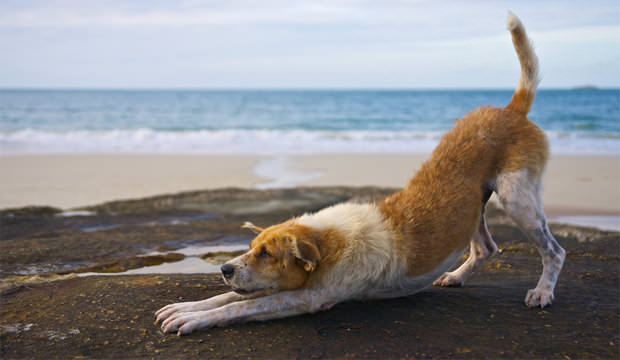
Toy dogs such as Chihuahuas sometimes perform this trick on their own as their large heads and small bodies make finding their balance a much easier task.
It is possible to teach larger dogs this trick, but you must proceed very slowly in order to prevent your dog from hurting himself.
Your dog will first need to build up the muscles used to perform this trick before he can perform it without assistance. Start by having your dog stand in front of a wall with his back legs raised on a book or small block.
Repeat this step for several sessions until he gets used to it. Over time, add more books or blocks to increase the height of your dog’s back legs. Once your dog is comfortable standing on as many books as possible, gently take his feet and place them on the wall.
Squeak Toys are available on Amazon – Click Here to Order
You will know when your dog is ready to proceed to each step by how well he raises himself off the ground to get into position. Once he is able to place his back feet on the wall without any trouble, hold a treat in front of his nose, and encourage him to move away from the wall. You may need to place a hand on his belly to help him get his balance at first.
9. Water fetch
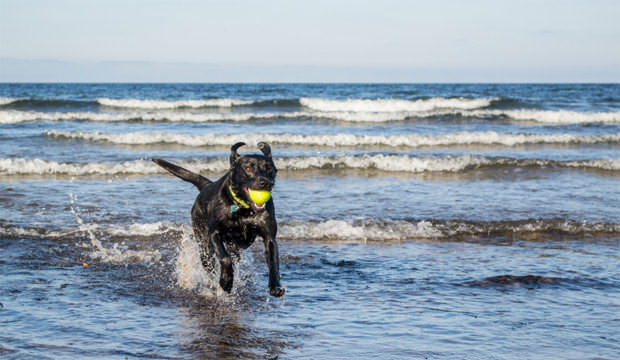
If you are heading out to the beach, pool or lake this summer, why not take your dog along, and use the opportunity to teach him a new trick?
Before your dog can learn how to fetch and retrieve items from the water, you will need to teach him how to swim.
This may sound strange to owners of Labradors or Spaniels that are natural swimmers, but smaller breeds and those with short legs may struggle to stay afloat.
If your dog belongs to any of the smaller breeds such as pugs, Bulldogs or Basset hounds, you may want to purchase a small life jacket for him to make swimming safer and easier. Start by getting into the water first and coaxing your dog to join you.
Keep your dog safe – Click Here to Buy cool Life Jacket
If you or a friend has another dog that enjoys swimming then bring them along to help your dog build up the confidence to get into the water. Start by standing on dry land and throwing a stick or ball into the shallowest part of the water. Praise and treat your dog every time he brings it back. Gradually throw the stick even further distances, but take care not to tire your dog out or push him too far.
10. Play piano
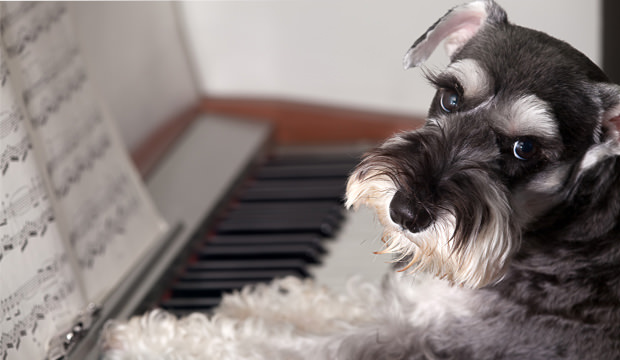
If your dog will do almost anything to earn treats, then teaching him to play the piano is extremely easy.
Larger dog breeds should be able to perform this trick with a standard size piano. Start by placing a toy piano or keyboard in the centre of a quiet room without any distractions.
As soon as your dog shows any interest in the piano, praise and reward him with treats. Keep the first few sessions short to ensure that your dog does not lose interest or become frustrated. Try tossing treats away from the piano whenever your dog shows an interest in it or nudges it with his nose and paw. As soon as he returns back to the piano, praise him enthusiastically, and toss another treat.
Once your dog begins to understand that good things happen whenever he approaches the piano, start limiting the amount of treats you give unless he concentrates his attention on the keyboard. Large and enthusiastic dogs may begin pressing keys without any prompting.
Treat your pupp with cool Bones – Click Here to Buy on Amazon
If your dog needs a little encouragement, try placing the treats on the keys so that he has to press them with his nose in order to win the treat. As soon as he presses a key, say the command “play” and reward generously.
11. Peek-a-boo

There are two different methods to teaching your dog this trick. If your dog can already give his paw on command, start by having him sit in front of you, and ask for his paw.
Grasp his paw in your hand, and then raise it over his eyes. Repeat the command gently, and treat him immediately.
Continue repeating the process until your dog makes the connection. Another way to teach this trick is by using a small piece of scotch tape.
Have your dog sit in front of you, and then stick a small piece of tape or a yellow post-it note to the end of his nose. Ensure the tape is not too strong or he will have trouble removing it. Wait for your dog to raise his paw to remove the tape.
Purchase Dog Treats – Click Here
As soon as your dog lifts his paw to his nose, praise him, and administer a treat. Continue with the tape until he begins to understand the command. Next, try simply tapping your dog’s nose gently to get him to raise his paw. If you repeat these steps whilst saying the command, your dog will eventually perform the trick automatically.
12. Walk backwards
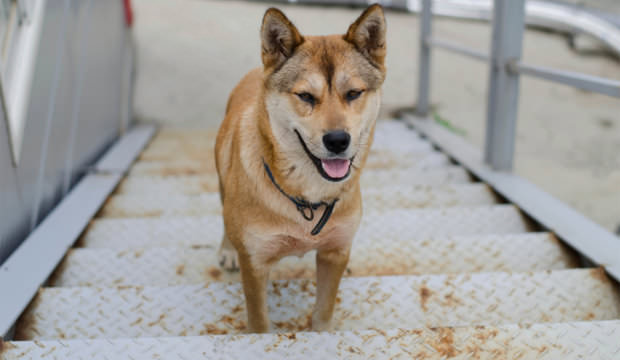
It is an extremely useful skill that will come in handy when you need your dog to back away from dangerous items or small animals.
It will also help him to develop his coordination and footwork. Start by calling your dog to you and commanding him to stay.
Take a few steps backwards, and then give the command “back.” Start walking towards your dog while repeating the command. Some dogs will instinctively back up as you walk towards them. If not, move towards your dog, and gently nudge him back using your legs and body.
Train your dog with “Affordable Agility in the Bag” – Buy on Amazon
You can also try holding a treat just over and behind his head to get him to walk backwards. As soon as your dog takes a step back, praise and reward him enthusiastically.
If your dog attempts to turn around, try practicing the trick in an enclosed space such as a narrow walkway or between parked cars. Once your dog has learned to walk backwards, try standing off to the side of your dog and holding the treat in front of him. Slowly start to turn whilst guiding your dog to walk backwards around you in a circle.
13. Open and close doors
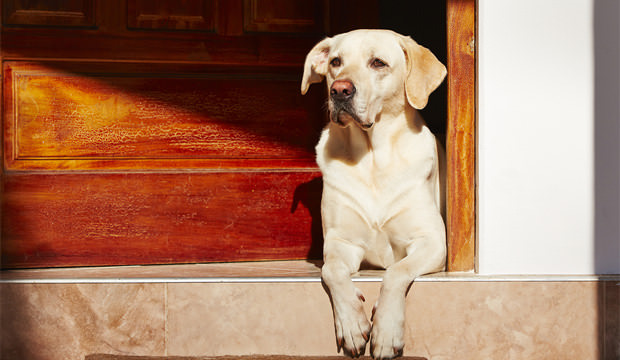
It is advisable to teach your dog to use a rope or tug toy tied to the door to open it rather than jump up at the handle.
Smaller breeds cannot reach door handles, and larger breeds will leave deep scratch marks in your doors if they try to open them excitedly.
Teaching your dog to only open doors that have ropes attached will also prevent him from opening exterior doors and making an escape.
Click Here to Buy “PetSafe Wall Entry Aluminum Pet Door”
Tie a rope or tug toy to the handle of your door, and encourage your dog to tug it. This works better on doors with moving handles. If you have doors with doorknobs that need to be turned, open the door slightly first to allow your dog to tug it fully open.
Once your dog begins to tug the rope, praise him, and encourage him to pull the door completely open. Only administer a treat once he has completed the trick otherwise he will focus all his attention on the treats. Once he has learned to open the door, hold a treat in your hand to encourage him to jump on the door to close it.
14. Fetch a drink from the fridge
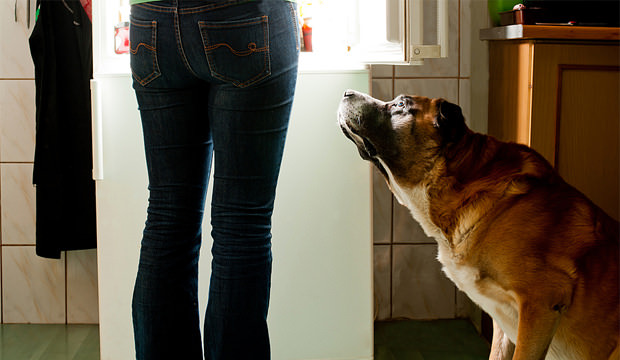
Only teach this trick if your dog has a certain level of self-control and will not attempt to eat all of the food in your fridge once he gets inside. Attach a rope or tug toy to the door of your fridge.
Encourage your dog to tug on it until the door pops open. Reward him immediately. Next, hold the treat against the outside of the open door, and encourage your dog to jump up with his front paws so that the door swings shut.
Spend some time perfecting these steps until your dog can do them with vocal commands only. Place your dog’s favourite toy in the fridge in a place where he can see it clearly. After he opens the door, show him the toy if he doesn’t see it.
Dog Rope Toys are availe on Amazon
Encourage him to take it out carefully and bring it back to you. Once he has got the hang of this step, replace the toy with a small plastic bottle. Never use pressurised aluminium cans for this trick unless your dog knows how to grip items gently.
15. Use the toilet
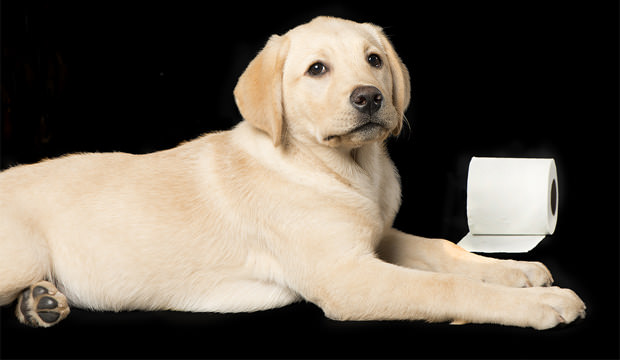
This can be one of the harder tricks to teach, but it is well worth the time spent getting it right.
It is also ideal for those with limited mobility who cannot take their dog outside several times a day and for those that work long hours.
Start by teaching your dog a command every time he goes outside to relieve himself. You can use the command “go to the toilet” or anything else that you find appropriate. Say this command every time your dog uses the toilet outside until he learns to associate it with relieving himself.
Once your dog learns to use the toilet on command, introduce a plastic litter box into the toilet routine. Take it outside, and place your dog’s front paws into the box while repeating the command.
Buy Indoor Dog Potty – Click Here
After a while your dog will learn to only use the toilet in the box. Next, bring the box into your home gradually. Start by placing it close to the door, and then slowly move it towards the bathroom. If your dog makes it this far, you can then place the box into the toilet, and encourage your dog to jump up on the toilet to relieve himself. Eventually, you will be able to remove the box altogether.
16. Play soccer
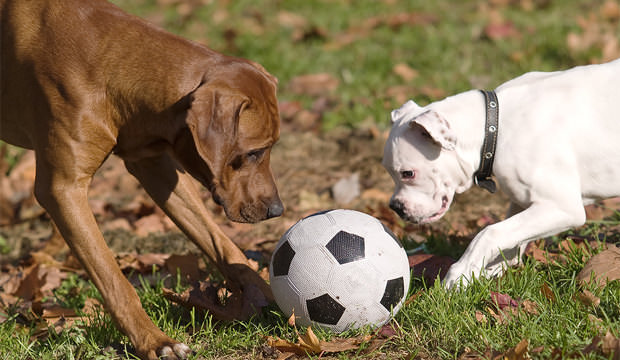
Choose a ball that is slightly larger than your dog’s mouth so that he cannot pick it up and carry it. Take your dog to an open space such as the back garden or an empty park.
Make sure you have a supply of treats to reward him whenever he performs well.
Start by getting your dog acquainted with the ball by leaving it in front of him and allowing him to smell it. If he starts moving the ball by himself, immediately praise him, but do not give him a treat at this stage. If your dog is not interested in the ball at all, start gently rolling it towards him while encouraging him to play with it.
Find a Ball Toy for your Pooch – Order on Amazon
Every time your dog touches the ball with his nose or paw, praise him immediately. It may take several sessions before your dog gets the hang of dribbling the ball, but it will happen eventually. Start kicking the ball longer distances away from you and encouraging him to dribble it all the way back. Reward him with a treat as soon as he returns with the ball.
17. Say prayers
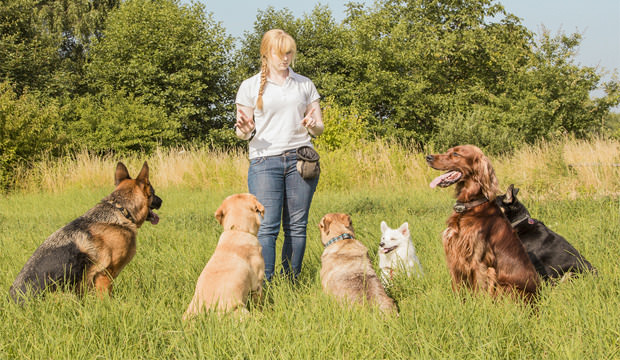
If your dog does not already know how to give his paw or beg, start by teaching these basic steps first.
Once your dog knows how to raise his front paws in a sitting position, extend your arm so that he rests his paws on your forearm.
It may take a few sessions to get this right. As soon as your dog puts his paws on you, immediately praise and reward him.
Spend some time allowing your dog to feel comfortable in this position before proceeding to the next step. Once your dog has mastered the first step, command him to place his paws on your arm, and then hold a treat in front of his nose. Slowly lower the treat underneath your arm so that your dog lowers his head until it is between his paws and underneath your arm.
Buy Dog Training Collars on Amazon
If he attempts to take his paws from your arm, remove the treat, and start again from the beginning. You may need to adjust your dog’s paws on your arm so that he has space to lower his head between them.
18. Sing to music
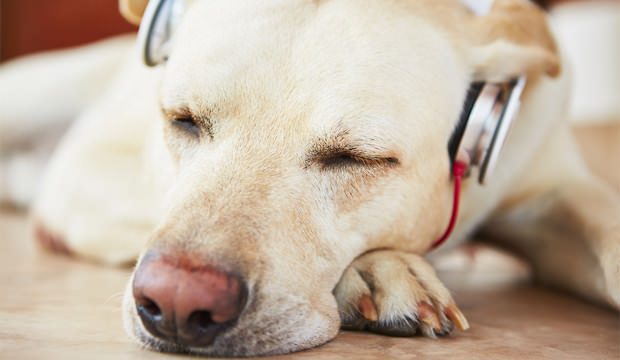
Others need a little more encouragement to show off their vocal talents.
This may not be the best trick to teach your dog if you live in an apartment or have neighbours living close by.
Some dogs will conduct their own practice sessions whilst you are out of the house which could drive your neighbours crazy.
Start by experimenting with different songs, tones and instruments to see if any of them inspire your dog to start singing. As you are the leader of the pack, lead by example, and start howling to encourage your dog to join in. Some dogs become more vocal when asking for something such as their food or a walk. As soon as your dog starts to make noise, say the command, and give him a reward.
Have fun with your pooch – Buy Dog Costumes Here
One of the most famous examples of musical dogs is the New Guinea Singing Dog that is a close relative of the Dingo. This wild dog emits a long melodious howl that is characterised by several high notes. No matter what breed you have, all dogs are descended from wolves, and most will eventually rediscover their howling abilities.
19. Slalom
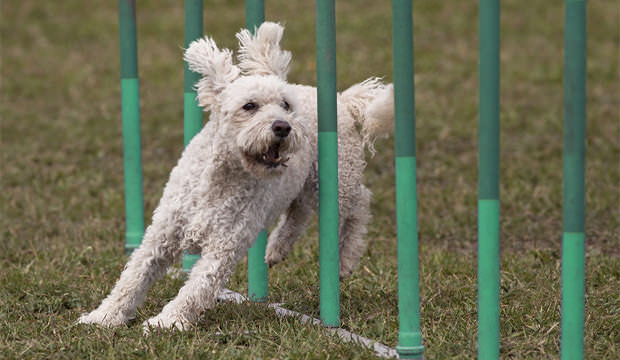
When first attempting this trick, it is advisable to use specially designed dog training slalom poles that will bend if your dog accidently runs into them.
Once your dog improves his skills, you can graduate to using trees, bollards and even people for him to weave in and out of.
Start with just four poles, and hold a treat immediately in front of your dog’s nose.
Entice him to follow the treat and slowly guide him in between the poles. Reward him with plenty of praise and the treat once he reaches the end. Gradually add more poles to the slalom course one at a time until you have around 10 or 15 poles for your dog to weave in and out of.
Buy “Weave Poles for Dog Agility’ and teach your dog slalom
It is essential to place the poles at equal distances apart to allow your dog to judge his movements correctly. Always use a tape measure when setting up your course. Once your dog has the hang of the trick, gradually increase the speed with which you guide him in between the poles.
You can also move the poles closer together to encourage him to turn sharply and improve his footwork. If you perform this trick outside with solid poles or trees, never encourage your dog to move fast to avoid him running into something and injuring himself.
20. Pick up his toys

Getting him to put them back again is a completely different issue. With a little patience and determination, you will eventually be able to teach your dog to clean up after himself.
Sit on the floor with your dog’s toy basket in front of you. Choose one toy, and throw it to the other side of the room. Once your dog chases after it, hold a treat over his toy basket, and call him back to you.
If he drops the toy before returning, remove the treat from his sight, and command him to fetch the toy. It may take a while for your dog to get the hang of this, and it is much easier if he already knows how to fetch.
Surprise your dog with new Squek Toy – Click Here to Buy
Once he returns to you with the toy in his mouth, hold the treat directly over the toy box, and command your dog to release the toy. When he drops it into the box, give him the treat and lots of praise. Repeat these steps, and slowly begin to move the toy box away from you. Hold the treat over the box by extending your arm, and work up to simply pointing towards the box.

Tricks?…..we have dogs that can unlock and open kennel doors, and all of the dog gates in the house have had to be modified as they had figured them out in days.
What type of dogs?
Miniature Bull Terriers…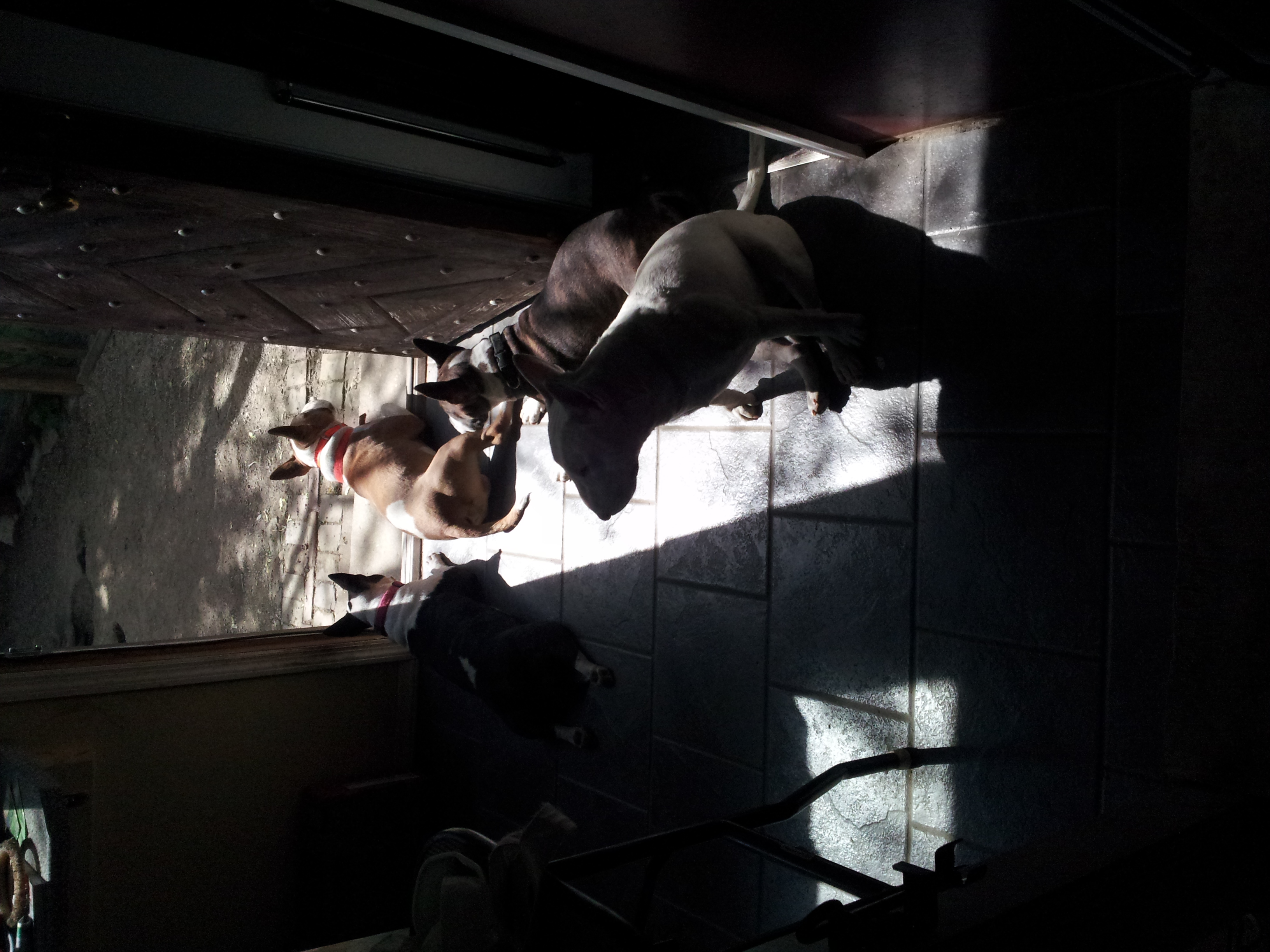
Miniature Bull Terriers…
Miniature Bull Terriers…
american bullies
I most certainly will NOT teach my dogs how to open the fridge door. All I need is for them to clean it out while I’m away or just not paying attention. They are very good at noticing when my back is turned when they are attempting to get away with something anyway. At least my Golden is….
Lucky for you, all of these tricks are optional. 😀 You don’t have to train any you don’t want.
Attach a rope to it for the pup to pull it open, so without the rope attached he/she wont know how to open it 🙂
well it be good if mine can pick it poo up
I love my dog but sometimes she does not listen she lays down a sleeps
Terrible methods. Dogs do NOT speak English. Yelling unknown words at them stresses them out becasue they do not understand waht you want, they need to be taught the action first, then the word once they fully understand the action.
I just want to point out that dogs recognize the tone of your voice and other sounds. And we arent yelling at them, we are talling as we are doing the activity or action. You can use other methods also. Just saying.
Before teaching your dog any of this I suggest getting your dog used to the sound of the piano first, then after that if its small have them in your lap while you play a song or two if they are larger sit them next to you(:
What if someone doesn’t play piano? 😀
I need one of those for my great dane.
hes a babby but a big one.
I jest had to stand out side in a cold wether.
and I am a girl I am 8 years old.
and my dog is not putty traind my puppy is a great dane .
for some reason she doesn’t want to do these tricks, I thinks its because she doesn’t want to eat
There’s one big mistake this article makes: you should always say the command WHEN the dog is doing it, not before. The dog needs to know that the command is linked with the action, so saying high-five before having him do it might not link the action to the word for him, as he will have forgotten the word already. Wait till he does it, then simultaneously say the command, and reward him, for him to learn the connection.
I love reading your posts, very light dialogue. Nice.
awesome dog tricks
i know exclusive only 3 steps and teach your dog properly.
I took my puppy from a dog foster home about a year ago. I love him to bits; he has a great personality, and I feel that he loves our family so much. BUT, he bites a lot. How to stop it?
My husband and I were thinking about taking him to ‘doggy school’, but then again, it’s extremely expensive, and the nearest ‘doggy school’ is far away from us. Maybe you have some advice? THANK YOU!!!!
When your dog bites you, you need to make a high-pitched squeal and immediately cease anything you are doing with him, turn your back to him, and walk away. This shows your dog that he’s hurting you (even if the bites don’t hurt, this is important) and that biting won’t get him anything he wants.
If the bites are hard enough to bruise or draw blood, then ignore what I’ve said and seek professional help.
I have a new lab puppy terrible biting and nipping. We tried flicking nose, slapping lightly, time outs ( put in laundry room for a few minutes and the Owee that hurts and ignore routine. None of that worked. I started with treats and holding my hand out, if he licked I said ” good ” and rewarded and said ” kisses as he licked” . It only took a few times and he is now kissing instead of biting!
Be careful of encouraging licking! There are people who have died from major infections caused by dogs licking their owners! It’s been in the news recently.Sometimes they lose whole limbs. Very nasty.
Oh also, walking and exercise will help with his energy level and help …
These are such fun tricks! How difficult would it be to teach my dog something like “dance?” I have been able to teach her “sit” over the past couple months, but it seems like it takes a long time. It also doesn’t help that I have a very busy work schedule.
My dog picked it up in seconds, he’s a beagle. what breed of dog is yours? You literally get a nice treat and raise it above their head until they jump.
You’ve made the investment in owning a pet, make it a priority to spend time training it. I have a 10 week old Lab pup that sits, stays, rollover, leave it ( anything I don’t want him to have) walks on leash, lays down, knows get out of the kitchen and stays out and shake. Took me a few minutes a day with treats as motivation and he now does these things for praise and the occasional treat as reinforcement . He is the best trained dog I’ve ever had and I’ve had dogs all my life. Positive reinforcement training… Read more »
Nothing wrong with some negative reinforcement too. At the age you mention, sure. But once you hit teenager you need more structure and a sharp “no!” – and on hard pups, you need a good jolt.
I train with positive, and reinforce with negative when I know he is refusing to do something he knows (and only then – with 2 exceptions. Fluff eating – which I am sure is like bacon cotton candy, and cat chasing. Those get high electric stimulus for safety reasons).
your dog is very smart and well motivated to please. That’s awesome.
Piano, Piano, Piano.
I took my puppy from a dog foster home about a year ago. I love him to bits; he has a great personality, and I feel that he loves our family so much. BUT he barks A LOT. . So, leaving home is always a challenge for us.
My husband and I were thinking about taking him to ‘doggy school’, but then again, it’s extremely expensive, and the nearest ‘doggy school’ is far away from us. Maybe you have some advice? THANK YOU!!!!
I have to say that it also dependents of what type of breed is the dog some of them might be very energetic and distracted while you try to teach them something so you need to be extra patient and start with something easy..don’t yell at your dog … Like someone said already they only recognise the tone of your voice. I got a collie which is 4months old I was told they are very smart and love to play a lot.I only have her only for almost week and she already call me to go out, give kiss, sit… Read more »
I was using justin boldoni technique from facebook and it work greats.